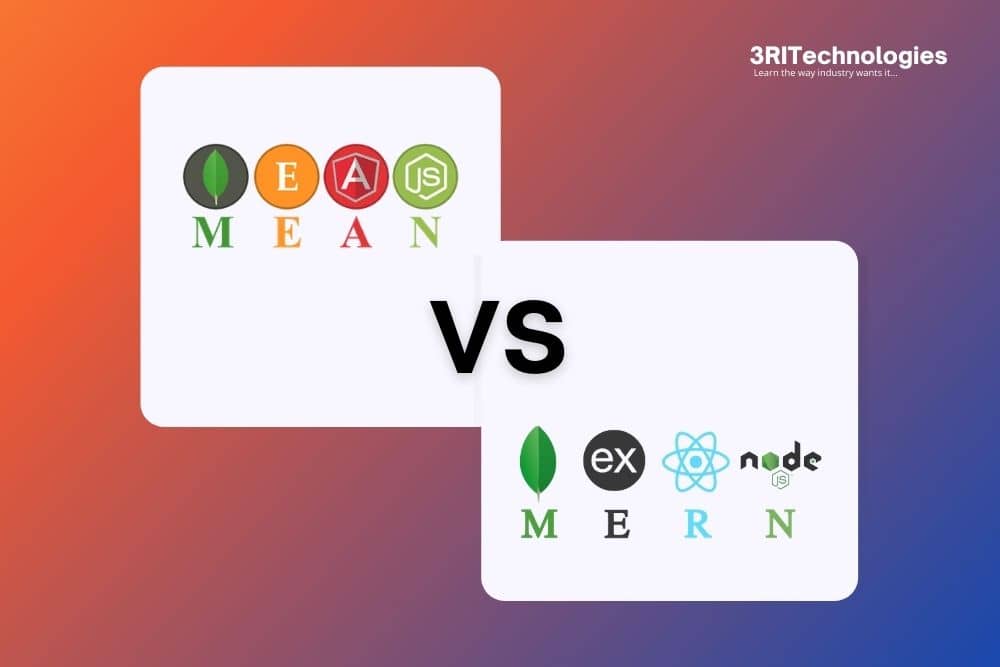Whether you’re an IT professional at a company or an entrepreneur with ambitions to build online and mobile applications, choosing the proper technological stack might be a little challenging. And you may have encountered a comparison between the MEAN and MERN stacks in this regard.
The debate of MEAN stack vs MERN stack is a prominent discussion among developers aiming to select the most efficient JavaScript framework for their web applications. Both MERN and MEAN stack offer robust, full-stack solutions, but their subtle yet significant variations can heavily influence project development, scalability, and performance. This comprehensive guide delves deep into the difference between MERN and MEAN stack, exploring their core components, advantages, disadvantages, and typical use cases to help you clearly understand MERN vs MEAN. For developers looking to specialize and gain in-depth expertise, particularly with the MongoDB, Express.js, Angular, and Node.js combination, our Mean Course provides an excellent learning pathway. Making the right choice between MEAN vs MERN can significantly impact your project’s success, and we’re here to equip you with the knowledge to decide confidently.
Digital world is constantly evolving, and we witness many technological advancements, and new market needs daily. Thus, having an app or a website is not the only method to develop your business in this digital era.
Choosing the appropriate technological stack for your organization will also affect its future growth. Which one will your company profit more? To find answers to these issues, you must first understand the fundamentals of these two entities, including their differences, similarities, and advantages. Therefore, let us analyze the difference between mean and mern stack.
Understanding the Core: What is the MEAN Stack?
It is a full-stack technology that is highly popular. MongoDB, Express.js, Angular, and Node.js are all abbreviations for MEAN. Programmers utilize this stack to create mobile and online applications.
MEAN is a free and open-source technological stack built on the JavaScript programming language. Because this stack includes necessary plugins and tools, it enables developers to build mobile and web applications quickly.
Explore your skill with the help of MEAN Stack Course in Pune.
The Benefits of the MEAN Stack
● Affordable. Each component of the MEAN stack is open-source, which significantly reduces development costs.
● The MEAN stack enables isomorphic code. It allows you to port code developed from one framework to another quickly.
● Angular is an open-source framework built on JavaScript that enables reusability, testability, maintenance, and high performance.
● It is open-source and cloud-compatible. MongoDB enables the application to send cloud operations by lowering the cost of circular space.
● MEAN stack enables seamless switches between server and client-side applications. It benefits developers by facilitating and expediting JavaScript development. To manage the entire project, developers must be familiar with JavaScript.
What exactly is the MERN Stack?
It is another open-source technology stack that fits the full-stack category. MongoDB, Express.js, React.js, and Node.js are together referred to as MERN. It makes it possible to create hybrid mobile web apps.
The MERN stack has been designed to facilitate development. It is a collection of frameworks, databases, and runtime environments built on the JavaScript programming language. This technology stack provides developers with an end-to-end framework, gaining popularity at a rapid pace.
Sign Up for MEAN Stack Online Training.
The Advantages of the MERN Stack
● Created with incredible community support.
● Numerous testing tools are pre-installed.
● The React library provides high-end development tools. Developers may freely use the library to create web applications.
● It facilitates development by utilizing the model view controller (MVC) architecture.
● Developers must be familiar with JavaScript and JSON to use this JavaScript stack.
● Developers may utilize React code on both web browsers and servers. This JS stack enables the creation of pages on the server as necessary.

MEAN vs MERN
The Curve of Learning
Node.js, MongoDB, and Express.js are all extremely popular technologies with extensive documentation. The learning curves for MEAN and MERN appear to be identical. Nonetheless, the learning curve for React and Angular will differ.
Angular is a template and typescript framework. You may discover that Angular has a higher learning curve, but React does not.
Revenue
Given that both MERN and MEAN stacks use Node.js, Express.js, and MongoDB, a profitability comparison between the two would indicate a preference for React over Angular.
Because Angular is a comprehensive framework, it offers increased profitability. Generally, you would utilize third-party React libraries that give lower designer productivity.
Angular has a CLI (Command Line Interface), which increases designer productivity. And when you rethink your code, you’ll see how much easier the Angular CLI makes it. Due to the availability of third-party libraries, maintaining your React code requires more effort.
Flow of Data
In the case of Angular, the data flow is bidirectional, which means that if you change the UI, the model state is instantly updated. The data flow in React is unidirectional. Thus, you may modify the user interface only after modifying the model state if you utilize React.
React’s unidirectional data binding provides a greater perspective of the data, which aids in managing big projects. As a result, the MERN stack is more suited to large-scale projects.
Angular’s bidirectional data binding becomes the more efficient option if you’re working on a small project. MEAN stack comes very handy here!
Support from a Third Party
Utilizing third-party libraries is another excellent consideration when developing enterprise-level applications. MEAN includes Angular, which includes built-in capabilities for HTTP call support and back-end integration.
Nonetheless, ReactJS provides several complementary frameworks for implementing comparable features. MEAN offers plug-and-play support for third-party extensions, whereas MERN requires different settings to do the same thing.
Code Management and Updates
With the added benefit of Angular, the MEAN stack simplifies code management and upgrades. Angular, being a well-organized and comprehensive framework, can aid the MVC design more effectively.
You may quickly isolate database-related code from UI-related code by implementing an intermediary layer that simplifies code management and upgrades. Due to the inclusion of third-party libraries, managing and upgrading React code requires extra effort.
Development of mobile apps
Angular provides the ionic framework for the development of mobile applications. It allows you to develop hybrid mobile apps. Because these applications use a single codebase for both iOS and Android, development costs are minimized. Hybrid apps, however, have reduced the native user experience.
React Native differs slightly in this regard. It delivers a near-native user experience; as a result, you may discover that the MERN stack is a superior choice for mobile application development.
Testing
Angular application testers have a unique experience compared to React application testers. It will generally affect your choice between the MEAN and MERN stacks. You can test an Angular app fast with only one tool, such as Jasmine.
It’s not the case, however, with a React application, where several technologies will require. You’ll need to test the JS code with a tool like Jest, while the elements may require testing with something like Enzyme. When developing a React application, you’re likely to use many third-party libraries; hence, your testing effort is amazing.
Flexibility and Security
MERN and MEAN stacks both offer industry-leading security. As a consequence, you can choose one.
However, MERN is more secure than MEAN because it is more scalable.
If you Want to make a career as a Web Developer, Visit MERN Stack Classes in Pune
Applications on a Large Scale
If you’re developing an eCommerce-related application, the MEAN stack is an excellent choice. It can serve as the foundation for dynamic web applications and facilitate the development of prototypes. I propose MEAN stack as a full-stack development platform for creating large-scale projects.
User Interface Requirements
Do you want a straightforward yet sophisticated UI rendering for your application? Then, proceed to the MERN stack to do this. It can instantly generate a frame and display it on the screen, ensuring a consistent user experience.
Development Team Expertise and Experience
Supporting documentation is not critical if your development staff is extremely knowledgeable and experienced with web frameworks. The learning curve in this scenario is less steep; therefore, you may select the MEAN stack.
If your development team has a modest degree of expertise, you must consider the learning curve, which is why the MERN stack is a better choice.
MVC Support
If you’re developing an enterprise-level application, you’ll need to keep to a comprehensive architecture. It is why you should select the MEAN stack rather than the MERN stack. More information about the MERN Stack course is at the MERN Stack Online Course
By selecting this, you’ll have access to the Model-View-Controller architecture’s support. You can, however, use the MEAN stack if your code is simple to handle.
CRUD Applications
The MERN stack enables you to quickly design and develops CRUD (Create, Read, Update, and Delete) applications from start to finish.
The use of React ensures that data changes are handled quickly and that the user interface is excellent. MERN is an excellent framework for developing mobile apps or single-page applications.
Error Prevention
If you’re looking for a stack to prevent fundamental coding errors, the MEAN stack is your best bet. Angular makes use of Typescripts, a framework that helps minimize common code errors throughout the development phase.
Improving and Maintaining the Long-Term
React and Angular are both extremely popular frameworks. However, React is growing in popularity, and hiring React developers will become more accessible in the future.
Consider utilizing the MERN stack if your application has a substantial upgrade pipeline, and you may anticipate considerable long-term maintenance requirements.
Performance
The MEAN stack uses Angular, which maintains the DOM current (Document Object Model). The DOM provides access to XML and HTML documents through a programming interface.
By contrast, MERN makes use of React to keep the virtual DOM updated. As a result, MERN enables faster application development.
As a result, no framework will ever be able to address all business objectives. To achieve a better outcome and fulfill your company goals, you must research each feature, match them to the rapid development requirements, and pick carefully.

Advantages of Hiring a MEAN Stack Developer
MEAN is a modern approach to the web development process and a collection of JavaScript apps that help in producing top-notch websites and applications. It also includes helpful tools, resources, and plug-ins that reduce development times.
With today’s technical breakthroughs, developing cutting-edge online apps will be more productive thanks to the advantages of MEAN stack web development with MEAN technologies.
The employment of a MEAN Stack Developer helps expedite the development of mobile or web applications. Working with a MEAN Stack Developer has the following advantages:
MEAN Stack Developers manage all phases of an application’s development, from the frontend (client-side) to the backend (server-side), using JavaScript.
They use MVC design and streamline the labor-intensive tasks, which expedites the development process.
They make suitable use of cutting-edge technology; that is, they use Node.js and Angular.js for front-end work and MongoDB and Express.js for back-end work.
They employ the framework in a way that facilitates the availability of popular plugins and speeds up system administration.
Skill Sets a MEAN Stack Developer Must Possess
• Proficiency in HTML, CSS, and JavaScript.
• Frameworks built with Javascript and CSS.
• Possess knowledge of the SDLC and the Agile environment;
• A fundamental comprehension of the requirements and processes on the client side.
• Recognize architecture, cloud technologies, and web designing and integration
• Able to create and develop websites using a variety of frameworks;
• A fundamental comprehension of the needs and procedures on the server side.
• Proficiency in the MEAN stack, including knowledge of Angular.js, Node.js, Express.js, and MongoDB. You must be familiar with VueJS or ReactJS if not Angular.
• A fundamental comprehension of the workflow and architecture.
• Acquainted with npm package management.
• It is required that you have communication, critical thinking, and time management abilities.
• It would be ideal to have knowledge of MotionUI and Git as design frameworks.
Things to Consider Before Choosing the Right Stack for Your Business
The decision on which tech stack to use for app development is based on a number of internal and external criteria, including developer expertise, project requirements, scalability requirements, and community support. Both internal and external factors need to be considered in order to make an informed decision.
Project specifications:
Examine the project specifications to determine whether the stack is feasible.
Knowledge of the Development Team:
It’s critical to assess your development team’s competency in the selected tech stack to make sure they have the requisite knowledge and expertise.
Resources and Needs
The features you have gathered and the size of your project will affect your development stack. It’s critical to take your budget into account because certain technologies could demand pricey software or license payments.
Expense of development:
Determine many economical approaches for the full development process.
New techniques:
Apply Agile development techniques to understand a market that is driven by customers.
Flexibility and viability:
To preserve flexibility, take note of the variations in database architecture and software solutions.
The integration
Finding out if the tech stack is compatible with additional tools and technologies that might be needed for your project is crucial.
Consumer Experience
Verify that the tech stack can satisfy user expectations and deliver a wonderful user experience.
Future-Proofing
Assess the IT stack’s adaptability to evolving market trends and technological advancements in order to future-proof it.
Duration To Market
You should use the selected tech stack to assess how long it will take to construct and launch the application.
Competitors’ investigations
It’s crucial to stay up to date with industry trends, but don’t copy your competitors. Remember that they may have different demands, goals, budgets, and team dynamics.
Prefabricated solution
It is more affordable to use open-source APIs rather than creating solutions from the ground up. They are modern, adaptable, and integrate well with other technology.
Cloud-Based Resolution
Cloud solutions provide security features like firewalls, encryption, and multi-factor authentication along with increased software scalability and reliability.
Real-world Examples Of MEAN
LinkedIn is a useful tool for researching businesses and connecting with hiring managers. Additionally, you may store job searches, apply for positions directly, and let recruiters and contacts know that you’re available for work. Engage in dialogue: Taking part in discussions on LinkedIn is quite simple.
PayPal
PayPal is used by customers to make purchases from applications, online retailers, and eBay. Payments to sellers are made through PayPal, deducted from any relevant transaction costs. We will provide the payment and transaction data to both buyers and sellers.
Intel
An Intel® processor carries out tasks by carrying out instructions in a predetermined order. In order to accomplish this, it retrieves instructions from memory, decodes them, runs them, and then puts the finished products back into memory.
Accenture
Andersen Consulting changed its name to Accenture in 2001, which stands for “accent on the future.” Accenture’s success and forward-thinking approach drove the business to make many acquisitions, enter into joint ventures, and create campaigns that set the standard for the industry.
The Weather Channel
The current weather is typically represented using weather station symbols. For rain and snow, a dot is utilized, and the amount of dots or asterisks indicates how much of each is occurring.
Conclusion
Due to the close competition between the MEAN and MERN stacks, choosing one or justifying both is quite difficult. After all, both technologies offer the greatest features and functionalities in their category. Therefore, use the MEAN or MERN stack to create a dynamic application based on your business requirements. To learn more visit 3RI Technologies.




